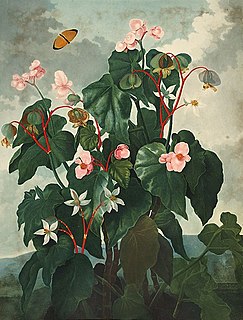
Begonia is a genus of perennial flowering plants in the family Begoniaceae. The genus contains more than 2,000 different plant species. The Begonias are native to moist subtropical and tropical climates. Some species are commonly grown indoors as ornamental houseplants in cooler climates. In cooler climates some species are cultivated outside in summertime for their bright colorful flowers, which have sepals but no petals.

Saxifraga stolonifera is a perennial flowering plant known by several common names, including creeping saxifrage, strawberry saxifrage, creeping rockfoil, Aaron's beard, mother of thousands, roving sailor, and strawberry begonia or strawberry geranium.

Begonia grandis, the hardy begonia, is a species of flowering plant in the family Begoniaceae. This herbaceous perennial has alternate, simple leaves on arching stems. The flowers are pink or white, borne in dichotomously branching cymes from late summer through fall in USDA U.S. Hardiness Zone 7. As the common name "hardy begonia" implies, it is winter hardy in some temperate regions.
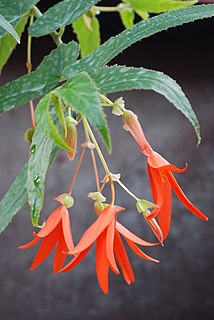
Begonia boliviensis is a plant in the begonia family, Begoniaceae, which was introduced to Europe in 1864 by Richard Pearce who discovered it in the Bolivian Andes, although the plant had previously been identified by Hugh Weddell in the same region but not introduced.

Begonia sutherlandii, known as the Sutherland begonia and as iwozya in Kimalila, Tanzania, is a tuberous flowering perennial plant in the family Begoniaceae, growing to 0.5 metres (20 in) with fleshy pink stems from 10 to 80 centimetres long. Leaves are commonly dark green and veined with red and covered with short hairs on the underside. They are asymmetrical in shape and the margin is toothed. Flowers, produced in pendent panicles throughout summer, are 20–26 millimetres (0.8–1.0 in) in diameter, and are usually orange or orange–red with yellow anthers.

Begonia listada, the striped begonia, is a species of flowering plant in the family Begoniaceae, native to Brazil. It is a compact shrublike evergreen begonia growing to 0.5 metres (20 in), bearing succulent green leaves with a prominent rib of lighter green, and a reddish underside. It produces small pink-tinted white flowers intermittently throughout the year. As it does not tolerate temperatures below 10 °C (50 °F), in temperate regions it must be grown under glass.
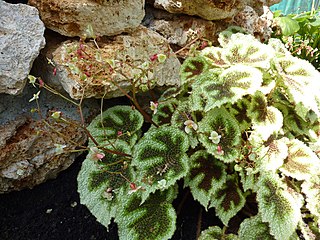
Begonia masoniana, the iron cross begonia, is a species of plant in the family Begoniaceae, native to southern China and northern Vietnam. It was originally described from cultivated plants of unknown origin and was only much later rediscovered in the wild. It is a rhizomatous perennial begonia growing to 0.5 metres (20 in), bearing large, asymmetrical, textured green leaves covered in reddish hairs, with a prominent dark brown pattern in the centre of each leaf, reminiscent of the German Iron Cross. It produces small white flowers in erect panicles, but is cultivated mainly for its foliage effect. In temperate regions it must be grown under glass, or in a completely frost-free environment. Not to be confused with the similar looking species Begonia variegata, from Vietnam. Although sometimes (incorrectly) considered a Rex begonia, this species is classified in the related section Coelocentrum.
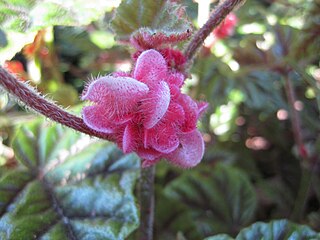
Begonia incarnata is a species of plant in the family Begoniaceae, native to Brazil. It is a shrublike evergreen perennial growing to 1 metre (39 in), bearing large, asymmetrical green leaves with a metallic sheen, and dark green veins. It produces small hairy pink flowers. As it does not tolerate temperatures below 10 °C (50 °F), in temperate regions it must be grown under glass.
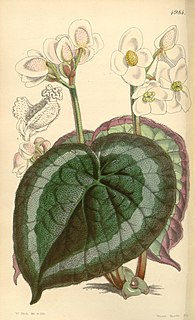
Begonia annulata, the ringed begonia, is a species of flowering plant in the genus Begonia native to the eastern Himalaya, Bangladesh, Assam in India, Myanmar, and Vietnam. It has gained the Royal Horticultural Society's Award of Garden Merit.

Begonia carolineifolia, the palm leaf begonia, palmate begonia or hand begonia, is a species of flowering plant in the genus Begonia native to central and southern Mexico and northern Central America. It has gained the Royal Horticultural Society's Award of Garden Merit.
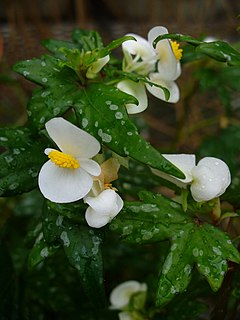
Begonia dregei, the maple leaf begonia or grape-leaf begonia, is a species of flowering plant in the genus Begonia native to South Africa. It has gained the Royal Horticultural Society's Award of Garden Merit.

Begonia imperialis, the imperial begonia, is a species of flowering plant in the genus Begonia, native to southern Mexico and Guatemala. It has gained the Royal Horticultural Society's Award of Garden Merit.

Begonia luxurians, the palm leaf begonia, is a species of flowering plant in the genus Begonia, native to southeastern Brazil. It has gained the Royal Horticultural Society's Award of Garden Merit.

Begonia radicans, the shrimp begonia, is a species of flowering plant in the genus Begonia, native to southeastern and southern Brazil. It has gained the Royal Horticultural Society's Award of Garden Merit.
Begonia solananthera, the Brazilian heart begonia, is a species of flowering plant in the genus Begonia, native to southeastern Brazil. It has gained the Royal Horticultural Society's Award of Garden Merit.
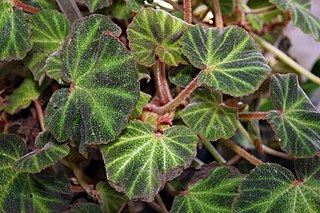
Begonia solimutata, the sun-changing begonia, is a species of flowering plant in the family Begoniaceae, native to Pará state in northern Brazil. It has gained the Royal Horticultural Society's Award of Garden Merit.

Begonia rex, the king begonia, is a species of flowering plant in the family Begoniaceae. It is found from Arunachal Pradesh to southeast China, and has been introduced to Bangladesh, Cuba, and Hispaniola. It is a parent to over 500 cultivars in the Begonia Rex Cultorum Group of houseplants. Other parents in the multitude of crosses made during the creation of the Group include Begonia annulata, B. cathayana, B. decora, B. diadema, B. dregei, B. grandis, B. hatacoa, B. palmata, and B. xanthina.

Begonia heracleifolia, the star begonia, is a species of flowering plant in the family Begoniaceae. It is native to Mexico and northern Central America, and has been introduced to Cuba, Hispaniola, Puerto Rico, and Trinidad and Tobago. A widespread species that is adapted to drought, it possesses considerable genetic and morphological variation, particularly in leaf shape and patterning.
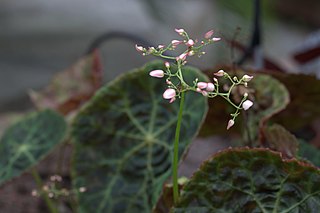
Begonia goegoensis, the fire-king begonia, is a species of flowering plant in the family Begoniaceae, native to Sumatra. In 1882 it was exhibited by Veitch and Sons and received a first class certificate from the Royal Horticultural Society. Valued for its striking red-backed leaves, it can be propagated from cuttings, although seeds may do better.
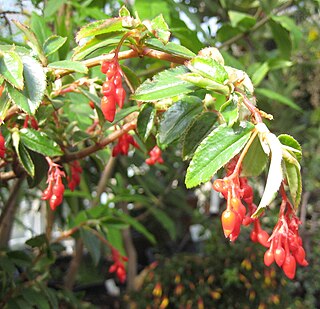
Begonia fuchsioides, the fuchsia begonia, is a species of flowering plant in the family Begoniaceae. It is native to Ecuador, Colombia, and western Venezuela, and has been introduced to Hawaii and Réunion. A small bush reaching 2 ft (60 cm), it is hardy to USDA zone 10a.



















